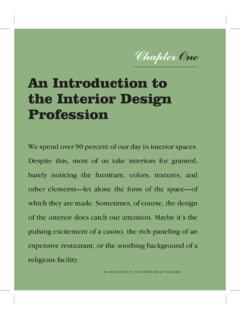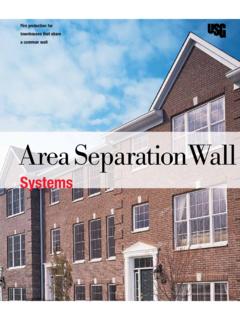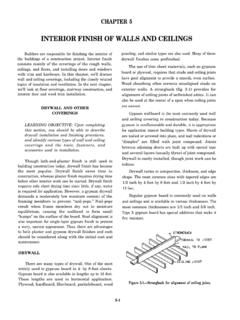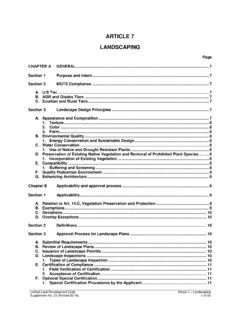Transcription of INTERIOR DESIGN 101
1 INTERIOR DESIGN 101 This report is free to read, share and publish under the terms ofCreative Commons Attribution License. 2010 Erica SwansonINTERIOR DESIGN 101 Table of Contents3 Page 4 Page 5 FunctionPage 6 Unity & HarmonyPage 8 RhythmPage 11 EmphasisPage 15 ScalePage 17 BalancePage 19 Page 22 LinePage 23 Form Page 27 ColourPage 28 PatternPage 33 TexturePage 36 Page 38 Page 39 Great style often flies in the face of established rules. Elusive, easy to recognize and difficult to define, true style is unconcerned with today s hottest trend and while it cannot be faked, it can certainly be nurtured and helped along. Understanding the basic elements and principles of INTERIOR DESIGN will bring you one step closer to understanding how, and when, to break the rules in creating your own personal style DESIGN is made up of five separate but equally crucial elements: line, form, colour, pattern and texture.
2 These five elements, and how closely or loosely they interact with one another, make up a DESIGN s overall , in turn, can be illustrated with seven basic DESIGN principles: unity, harmony, rhythm, emphasis, scale, balance and most importantly, function. These principles are the tools designers use to create a successful DESIGN scheme; think of function as the overarching objective and the remaining principles the means for achieving this am a firm believer in the axiom, `form follows function . While making a space more aesthetically appealing is certainly important, no amount of colour or beautiful furniture will transform an unworkable space into one that functions well. Before you begin any project, it s crucial to review your lifestyle, patterns, habits, and daily routines before any DESIGN or decorating decisions are made.
3 Is your space supporting or hindering you? Are you able to complete your regular routines with ease? Does your home give you a sense of emotional comfort and physical ease? While it s certainly helpful to have an understanding of blueprints and elevations, this stage is really about common sense; a determination of what needs updating and changing to better suit the needs of you and your family. Following the questions above, begin by getting clear on your exact needs now and in the future. For instance, do you need more counter or storage space in the bathroom for the morning rush? What about extra seating for holiday entertaining? Are your closets bursting with out-of-season clothing or hardly-used linens? Do you have enough display space for your ever-growing collection of art?
4 You ve thought critically about how you live and how your space may or may not be working for you, you can begin to draw up a Wish List of all the things you d love if money were no object. While all of your ideas may not be possible, lateral thinking often reveals simple solutions to previously unsolvable course, function refers to the items within your home as well. If you re inclined to lazy Sunday afternoon naps on the sofa, there s no sense in purchasing an armless loveseat. If there are small children or pets in the house, you might wish to reconsider white upholstered furniture. Every object, from your furniture to your storage racks, should perform efficiently and with the minimum of care and maintenance you can realistically your plans involve a decorative update or a complete to-the-studs overhaul, a home that functions well is the critical foundation to successful DESIGN .
5 Always function first, form and harmony is simply an orderly blend of lines, forms, colours, patterns and textures. While unity refers to the carful avoidance of visual conflict, harmony assures the assimilation of various elements and objects throughout the room to create a unified describes the relationship between each of the various parts of a space and how they relate to one another. If the room is traditional and feminine with a softly coordinating colour palette, the introduction of heavily linear or starkly modern furniture will throw off the entire composition. Similarly, a coat of glossy paint in a singular colour can unify mis-matched furniture or frames to create a harmonious can be achieved by thinking of the overall desired mood of the space.
6 A blend of similar furnishings and monochromatic colours can be used to induce of peaceful, calming feeling. Likewise, the introduction of angular objects set against softly rounded pieces can inject a visual tension to produce an exciting, dynamic feeling so long as those pieces have a unified feel and aesthetic. The repetition of frames or other types of artwork can unify a disjointed space and coordinating fabrics can fuse together upholstered furniture from different eras and styles to bring the whole seemingly disparate look there are no hard and fast rules, unity and harmony are achieved by paying particular attention to the overall look and feel of your space. The goal is to link common furnishings, accessories or decorative elements in colour, style, or form to create an overall pleasing visual DESIGN by David Powell of Powell & BonnellPhotography by Ted YarwoodVia Canadian House & HomeNotice how the overall formality of the architecture is unified with the furnishings by the judicious use of colour.
7 The softness of the walls is echoed in the softly coloured furnishings and draperies. The area rug s palette is also soft and subdued. Harmony is achieved with the introduction of dark and moody artwork. While boldly modern and abstract, the colours are in harmony with the rest of the room and help unify the scheme by echoing the darker finish of the coffee and end is especially powerful. Your eye should move easily around the room from one object to another without being jarred or tripped up by any one object in particular. There are exceptions to this, of course, such as the deliberate placement of a show-stopping piece or situations in which the furniture placement takes advantage of a captivating view. For most situations, however, the focus should remain on creating a sense of rhythm through repetition and contrast to create visual interest.
8 This can be achieved by utilizing the same colour or pattern at various intervals to keep the eye moving throughout the room or by directing the eye to various points through the use of similar forms or any case, rhythm lends a sense of visual cohesiveness and should be considered an important component of your overall regular rhythm is achieved by keeping the intervals between the objects relatively the same. This approach tends to be formal in hanging the images in a grid-like pattern, you eye travels from the artwork to the square furnishings, then to the square coffee table and on to the square floor tiles. Through repetition, your eye is drawn around the room easily without being jarred or stopping abruptly in any one DESIGN by Joe Serrins StudioPhotography by Vicky MokbelVia Architectural rhythm has a more natural, organic appearance and isn t as concerned with uniformity.
9 Flowing rhythm is also generally much more this image, your eye is drawn around the room through the repetition of the circular shape. Beginning with the sculptural mirror to the circular area rug, on to the circular table and finally to the circular bolster pillows, the continuity of the circular shape gives the room a sense of flow and effortless DESIGN by Diana VinolyPhotography by Thibault JeansonVia Elle rhythm, by far the most dynamic of the three, is concerned with deliberately leading your eye around the room for a particular effect. Progressive rhythm is most easily achieved with accessories such as graduated accessories for instance, or with patterns or shapes that force the eye to follow. The circular-backed sofa in the room to the left draws the eye around the room in one sweeping motion.
10 Without this, the room may have appeared boxy, stilted and uncomfortably DESIGN by Diana VinolyPhotography by Thibault JeansonVia Elle refers to the focal point of a space. A natural focal point occurs in rooms with a singular purpose such as a bedroom, where attention is given to the most prominent piece in the room. Created focal points can be seen in rooms with more than one purpose; living rooms and family rooms, for instance, where the rooms are large enough to contain more than one point of visual interest. It must be noted, however, that these two points should never compete; they must blend and relax with each other, making it comfortable for the room to contain both. One of the points of interest should visually dominate and take `centre stage , while the other creates a balancing effect to the eye.










